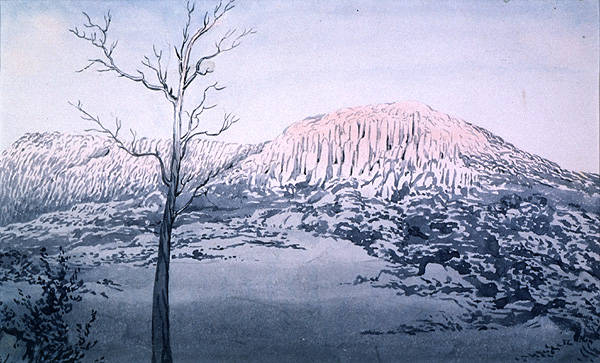 |
 |
|
Mount Wellington
Mount Wellington lies directly behind Hobart and is the city's dominant feature. It is 1,270 metres high and was formed during the Permian, Triassic and Jurassic ages. The Organ Pipes are the predominant feature, named for both appearance and sounds produced by the wind. The Van Diemen's Land Aborigines were the first to see the Mountain, calling it either Unghanyahletta or Pooranetere. The first white man to record its existence was Lieutenant William Bligh in 1788. During early exploration the Mountain underwent many name changes, including Table Hill, Montagne du Plateau, Skiddaw, Mount Collins, and Table Mountain after its similarity to Table Mountain, Cape of Good Hope. Between 1822 and 1824 it was re-named Mount Wellington after the Duke of Wellington. George Bass was the first white man to climb the Mountain, in 1798. During settlement the Mountain's greatest asset was water, firstly from the Hobart Rivulet and later carried from mountain streams through an extensive system of aqueducts, pipelines and reservoirs to supply the town below. For over a hundred years Mount Wellington was exploited for its natural resources – timber, stone, food, ice, skins, ferns and seeds. Timber was the main commodity – wattle, she-oak, stringy bark and blue gum – and was used for building and firewood. Tree ferns were cut down and used extensively for decoration and lined the streets and arches during the Royal Tour in 1901. Concern by conservationists and tourist promoters regarding denudation began in 1870, but it was not until 1906 it was declared a Public Park. The cliffs, boulder fields, swamps and gullies provide diverse habitat for fauna and flora. During the nineteenth century Mount Wellington became a mecca for botanists. Examples of flora and fauna were sent to England for examination and classification and many still bear the names of the botanists who collected them. New discoveries continue to be made. Over 400 plant species are found on Mount Wellington while 62 species of birds were recorded in 1976. Animal life is mainly nocturnal. Snakes, frogs and lizards are common during the day. A living fossil, Anaspides tasmaniae, a tiny fresh water shrimp, was recorded in 1837. Mount Wellington has a vivid history. It has been devastated by fire and flood; the scar of a major landslip is clearly visible. It has provided sites for weather stations, AUSSAT's Barth Station and telecommunication facilities. Recreational purposes have included bushwalking, foot racing, cliff climbing and sightseeing. Many huts were built on the Mountain and by the 1930s a network of tracks existed. The Mountain was also popular with skiers, but lost favour when the snow became unreliable. The Pinnacle Road, opened in 1937, enables easy access to the top. Mount Wellington continues to be Hobart's major tourist attraction, offering spectacular panoramic views of the city, river, land and sea below. Further reading: RM Johnston, Systemic Account of the Geology of Tasmania, Hobart, 1888; M Banks, 'The Geological History of Mt Wellington', Tasmanian Tramp 13, Hobart, 1957; DB Learman & KD Corbett, Mt Wellington Walk Map, Hobart, 1980; W Curtis, Forests and Flowers of Mount Wellington, Hobart, [1969]; H Guilline, Mt Wellington Walk Map, Hobart, 1980; E de Quincey The History of Mount Wellington, A Tasmanian Sketchbook, Hobart, 1987. Elizabeth de Quincey |
Copyright 2006, Centre for Tasmanian Historical Studies |
